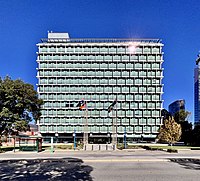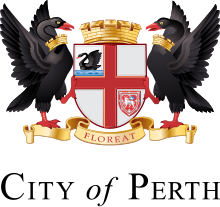31°57′S 115°51′E / 31.950°S 115.850°E
| City of Perth Western Australia | |||||||||||||||
|---|---|---|---|---|---|---|---|---|---|---|---|---|---|---|---|
 Perth Council House has been the council seat since 1963 | |||||||||||||||
 The City of Perth within the Perth Metropolitan Area | |||||||||||||||
 | |||||||||||||||
| Population | 28,463 (LGA 2021)[1] | ||||||||||||||
| Established | 1856 | ||||||||||||||
| Area | 20.01 km2 (7.7 sq mi)[2] | ||||||||||||||
| Lord Mayor | Basil Zempilas (Liberal) | ||||||||||||||
| Council seat | Council House, Perth | ||||||||||||||
| Region | Central Perth | ||||||||||||||
| State electorate(s) | |||||||||||||||
| Federal division(s) | |||||||||||||||
 | |||||||||||||||
| Website | City of Perth | ||||||||||||||
| |||||||||||||||
The City of Perth is a local government area and body, within the Perth metropolitan area, which is the capital of Western Australia. The local government is commonly known as Perth City Council. The City covers the Perth city centre and surrounding suburbs. The City covers an area of 20.01 square kilometres (8 sq mi) and had an estimated population of 21,092 as at 30 June 2015. On 1 July 2016 the City expanded, absorbing 1,247 residents from the City of Subiaco.
History
edit
In 1829, Captain James Stirling founded Perth as part of the Swan River Colony. A Perth Town Trust was formed in 1838, but remained largely non-functional for many years due to lack of finance and administrative capacity leading to its dissolution in 1858.[3] The City of Perth was officially declared on 23 September 1856[4] with Council meeting for the first time in December 1858.[5] In 1871, the City of Perth was reconstituted as a Municipal Corporation.
In 1915, following the efforts of WE Bold and the greater Perth movement, the City absorbed the Municipality of North Perth (1901) and the Municipality of Leederville (1895), and on 1 November 1917, the Municipality of Victoria Park was also absorbed. A year later, it absorbed territory from Perth Road Board (including the Belmont Park Racecourse) and purchased the 526 hectares (1,300 acres) Limekilns Estate in the western suburbs. The City developed the suburbs of Floreat Park, Wembley Park and City Beach on these lands.
In 1925, a new City of Perth Act gave the City additional powers over building control and regulation, including the power to declare new streets. In 1930 the first town planning committee was established.
Criticism of the City’s governance by the David Davidson, the state's Town Planning Commissioner, led to a Royal Commission in 1938 on the grounds that the development of the western suburbs had led to the neglect of health and building administration in the central city area.[6]
By 1962, the council had 27 members representing nine wards.[7] In 1963 the Metropolitan Region Town Planning Scheme Act required the City to establish a town planning department—which they did by appointing architect Paul Ritter in 1965.[8] Ritter’s two year tenure was short and turbulent, leading to public conflict with councillors and his termination in 1967.
The City’s first town planning scheme was submitted to the Town Planning Board in 1973, but not formally adopted until 1985. The reason for the delay was a state government desire to take discretionary powers out of the hands of the Council. Council was felt to be too easily influenced by powerful developers.[9]
On 1 July 1994, following the passage of the City of Perth Restructuring Act (1993), the City of Perth was broken up and a significantly reduced City of Perth constituted. The Town of Shepperton, Town of Cambridge and Town of Vincent were created from the former boundaries of the City.[10] The first elections were held on 6 May 1995, with eight councillors and a mayor.
The City of Perth Act 2016 defined Perth as the capital of Western Australia,[11] and expanded the City's boundaries to include a number of landmarks including Kings Park, University of Western Australia, Perth Children's Hospital and the Queen Elizabeth II Medical Centre. The boundary changes took effect on 1 July 2016.[12] Approximately 1,247 residents from Nedlands and Subiaco in the City of Subiaco were transferred to the City of Perth, and the City expanded to a total area of 20.01 square kilometres (8 sq mi).[2]
The Perth City Council was suspended on 2 March 2018, pending the establishment of a public inquiry into the council, by Local Government Minister David Templeman. The council was administered by three Commissioners until 18 October 2020. The two-year Inquiry carried out up until that point, conducted at a cost of nearly A$8.0m made many findings, none of which resulted in criminal conviction.[13]
In July 2021, the City of Perth formally recognised the Whadjuk Noongar people as the traditional owners of Noongar Country, the land on which the "City of Perth (Boorloo)" is located, signing the agreement "Yacker Danjoo Ngala Bidi"[14] with Whadjuk elders on 10 August.[15]
Council
editElection results
edit2023
edit| Party | Candidate | Votes | % | ±% | |
|---|---|---|---|---|---|
| Independent | Catherine Lezer (elected) | 911 | 16.57 | ||
| Independent | Bruce Reynolds (elected) | 827 | 15.04 | ||
| Labor | David Goncalves (elected) | 547 | 9.95 | ||
| Independent | Crawford Yorke | 519 | 9.44 | ||
| Independent | Raj Doshi (elected) | 442 | 8.04 | ||
| Independent | Glennys Marsdon | 420 | 7.64 | ||
| Independent | Bronte Macmillan | 365 | 6.64 | ||
| Independent | Will Leyland | 361 | 6.57 | ||
| Independent | Naijiao (Jason) Bo | 330 | 6.00 | ||
| Greens | Isabella Tripp | 304 | 5.53 | ||
| Independent | Dave Lee | 244 | 4.44 | ||
| Independent | Shirley Vine | 227 | 4.13 | ||
| Total formal votes | 5,497 | 98.76 | |||
| Informal votes | 69 | 1.24 | |||
| Turnout | 5,566 | 33.00 | |||
2021
edit| Party | Candidate | Votes | % | ±% | |
|---|---|---|---|---|---|
| Independent | Liam Gobbert (elected) | 1,793 | 10.82 | ||
| Independent | Clyde Bevan (elected) | 1,705 | 10.29 | ||
| Independent Liberal | Brent Fleeton (elected) | 1,654 | 9.98 | ||
| Independent Labor | Viktor Andrew Ko (elected) | 1,303 | 7.87 | ||
| Independent | Raj Doshi | 1,291 | 7.79 | ||
| Independent | Steve Hasluck | 1,179 | 7.12 | ||
| Independent Liberal | Bruce Reynolds | 1,030 | 6.22 | ||
| Independent Liberal | Kylee Veskovich | 954 | 5.76 | ||
| Independent | Deni Symonds | 948 | 5.72 | ||
| Independent | Jeff Broun | 873 | 5.27 | ||
| Independent | Cath Hewitt | 728 | 4.39 | ||
| Independent | Gloria Zhang | 720 | 4.35 | ||
| Independent | Andrew Toulalan | 648 | 3.91 | ||
| Independent | Daniel Ortlepp | 635 | 3.83 | ||
| Independent | Michelle Rosenberg | 621 | 3.75 | ||
| Independent | Jackie McKay | 483 | 2.92 | ||
| Total formal votes | 4,629 | 99.32 | |||
| Informal votes | 32 | 0.68 | |||
| Turnout | 4,661 | 28.55 | |||
Suburbs
editThe suburbs of the City of Perth with population and size figures based on the most recent Australian census:[19][20]
| Suburb | Population | Area | Map |
|---|---|---|---|
| Crawley * | 3,975 (SAL 2021)[21] | 1.4 km2 (0.54 sq mi) |  |
| East Perth * | 11,681 (SAL 2021)[22] | 3.2 km2 (1.2 sq mi) |  |
| Nedlands ** | 10,561 (SAL 2021)[23] | 5.4 km2 (2.1 sq mi) |  |
| Northbridge | 1,420 (SAL 2021)[24] | 0.5 km2 (0.19 sq mi) |  |
| Perth * | 13,670 (SAL 2021)[25] | 4.6 km2 (1.8 sq mi) |  |
| West Perth * | 6,102 (SAL 2021)[26] | 2.2 km2 (0.85 sq mi) |  |
* The parts of these suburbs north of Newcastle and Summers Streets fall within the City of Vincent. These localities are only partially contained within the City of Perth boundary.
** The parts of these localities were transferred from the City of Subiaco in 2016. These localities are only partially contained within the City of Perth boundary.
Population
editPre-1915 composition
editThis article needs additional citations for verification. (October 2016) |
| Year | Population |
|---|---|
| 1911 | 35,767 |
1915–1994 composition
edit
|
|
The 1991 population has been broken down by the Australian Bureau of Statistics as follows: Perth (C) 7,604; Cambridge (T) 22,740; Victoria Park (T) 24,313; Vincent (T) 24,765.[27]
1994–present composition
edit
|
|
Twin towns and sister cities
editThe City of Perth is twinned with:
Flag and coat of arms
edit | |
| Use | City |
|---|---|
| Proportion | 1:2 |
| Adopted | 1975 |
The official Flag of Perth represents the city of Perth, Western Australia. It features the Saint George's Cross overlaid with the coat of arms of Perth in the centre. Though the designer of the flag is unknown, it is thought to have been designed prior to 1872. In the 1920s, the black swan was removed from the top left quadrant of the flag and replaced with the coat of arms in the centre of the cross.[29][30][31]
The coat of arms were originally granted to the City of Perth on 2 December 1926. They were altered with the addition of part of the arms of Perth, Scotland in 1949.
Heritage listed places
editAs of 2024[update], 1,032 places are heritage-listed in the City of Perth,[32] of which 226 are on the State Register of Heritage Places.[33]
References
editExternal links
edit







